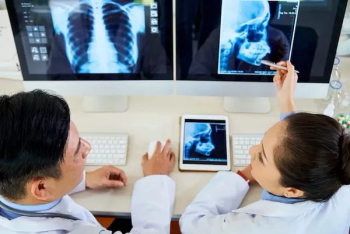
Non-Imaging Biomarker Measurement Can Reduce Breast Biopsies by 30 Percent
Including a measurement in diffusion-weighted imaging on contrast-enhanced MRI can help women side-step unneeded procedures.
Using a threshold value for a non-invasive imaging biomarker alongside contrast-enhanced MRI could reduce unwanted breast biopsies by approximately 30 percent, according to new research.
The infrastructure already exists to evaluate the apparent diffusion co-efficient (ADC), the measure of the magnitude of the diffusion of water molecules within tissue. Investigators from a multi-institutional team were interested in seeing whether setting a specific cutoff for ADC would allow for downgrading BI-RADS 4 lesions in an effort to sidestep unnecessary biopsies.
The team from Austria published their findings in
When it comes to pinpointing breast lesions, contrast-enhanced MRI is highly accurate. However, it can sometimes be difficult to determine whether a node is malignant or if inflammation is causing increased blood flow. To overcome this challenge, the team integrated diffusion-weighted imaging (DWI) with their conventional MRI protocol to capture the ADC measurement.
“DWI enables us to characterize lesions much better [because] hydrogen molecules ‘dance’ faster in healthy tissue than they do in malignant tumors,” said lead study author Paola Clauser, a radiologist from the department of biomedical imaging and image-guided therapy at MedUni Vienna and Vienna General Hospital. “Carcinomas alter tissue on a microscopic scale and, thereby, inhibit the motion of water molecules. We have now shown that we do not need to take biopsies from breast tumors, if the threshold value (ADC) [is below a certain level.]”
Related Content:
To reach this conclusion, the team conducted a retrospective, cross-sectional study, using data from five institutions. They enrolled 657 women with 696 BI-RADS 4 lesions that were identified on contrast-enhanced MRI.
Two breast radiologists evaluated the images and collected data on lesion morphology, size, and ADC. The team applied a previously suggested ADC cutoff of ≥1.5 × 10−3 mm2/second during their evaluation, and a negative likelihood radio of 0.1 or lower was considered as a rule-out criterion for breast cancer.
Based on their assessment, Clauser said, the team determined disease prevalence was 59.5 percent (414 out of 696 lesions) with an area under the ROC curve of 0.784. Among those lesions, when the team applied to ADC cutoff, they identified a sensitivity rate of 96.6 percent (400 out of 414 cancerous lesions).
As a result, Clauser said, implementing the ADC cutoff could potentially lead to a 32.6-percent drop in unnecessary breast biopsies, helping women avoid the associated pain, stress, and additional cost.
Applying the cutoff can also be done without any obstacles, said Pascal Baltzer, associate professor in the department of biomedical imaging and image-guided therapy at MedUni Vienna.
“[The biomarker] can be used anywhere, since it is largely independent of the equipment, the experience of the radiologist, the measuring time, and the measuring technique,” he explained. “Our finding can be used immediately for diagnostic purposes. It does not require a special center – every registered radiology department would be able to use it straightaway.”
In future work, Baltzer said, the team will attempt to further reduce unneeded breast biopsies.
For more coverage based on industry expert insights and research, subscribe to the Diagnostic Imaging e-Newsletter
Newsletter
Stay at the forefront of radiology with the Diagnostic Imaging newsletter, delivering the latest news, clinical insights, and imaging advancements for today’s radiologists.




